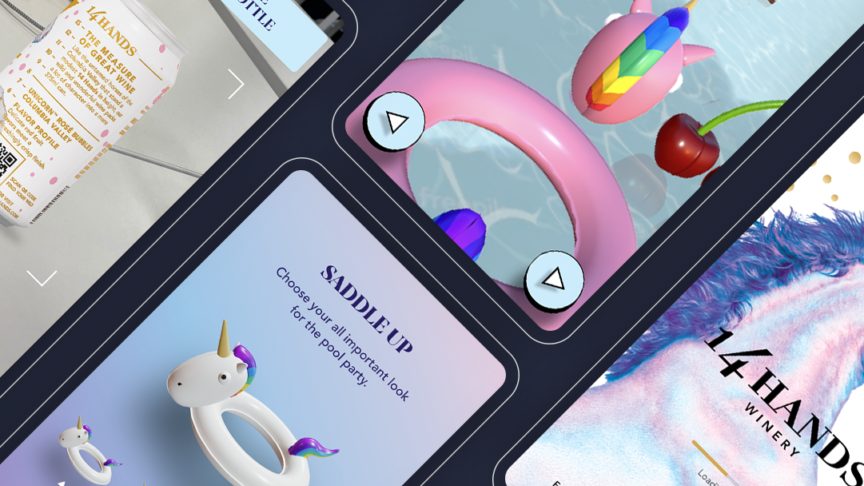Artist Carla Gannis on Using Blippar and Augmented Reality in Her Art
March 17, 2016
Artist Carla Gannis on Using Blippar and Augmented Reality in Her Art

Selfie culture has unforgivingly infiltrated modern society, love or hate them, you have likely been involved in a few! Through partnering with UNBOX London and Blippar, the artist Carla Gannis created "The Selfie Drawings Project." Here, Carla tells us more about the project and how AR played a vital part in expanding her canvas.
Tell us about your latest project A Subject Self-Defined. What was the inspiration behind it?
A Subject Self-Defined is the title for my current solo exhibition at Transfer Gallery in Brooklyn, NY. It is one translation, through 4K looped videos, of The Selfie Drawing series I began in January 2015. I was down South (as in the Southern United States), where I’m originally from, visiting my family. I’d recently gone through a break up, moved to a new apartment in Brooklyn, and was sorting out who I was, as a woman and an artist, in this shifted context. One day while there I began making iPad drawings of my 99 year old grandmother, Pansy Mae, (she turned 100 this past December 31st!). At some point, I stopped drawing, took a photo of her, and then of myself. I started looking at my own “selfie” iPhone pic, and quickly began to draw it on my iPad. Over the course of a year I completed 52 digital drawings, a kind of hybridization of selfie photography with more traditional self portraiture. After each completion of a drawing I would upload it to several social media platforms. I mean, is it a selfie if it is not uploaded to a network?
I felt vulnerable at first, speaking more directly through my own voice, and in essence performing my identity online. As I continued making the drawings they began to take on broader dimensions outside of personal self-analysis and reflection. I began to weave together art historical and literary references with current technological and cultural tropes, finding collision points for visual storytelling. At some point I was no longer merely playing the “role of Carla Gannis,” I was setting up scenarios to represent different types of women, for example a woman in her bedroom simultaneously channeling cheerleading moves, Wonder Woman and Shiva while wearing an iPhone strapped to her head; a woman facing the implications of post-humanism and artificial intelligence by 3D printing her body as a replacement for her physical body in a Google Deep Dream environment; a “Nude Descending a Staircase” (after artist Marcel Duchamp), this time descending from a spaceship, recording device in hand, as she enters a flooded, stormy environment seemingly on the brink of disaster.
In January 2016, I premiered A Subject Self-Defined as a narrative expansion of the drawings through time-based media. On four 10 x 10 ft screens in the gallery 4 “psychological seasons” are projected as panoramic videos. 12 months of square format videos are also projected. It is an all encompassing, immersive physical experience of “virtual video.” Also, in collaboration with Blippar and UNBOX I am thrilled to have released The Selfie Drawings project as a book. This hardcover, limited edition art catalog transcends the parameters of a physical book, as contained within it, released over the period of a year (beginning March 5th, 2016), 52 augmented reality experiences are coming to life. Together we have produced a serialized augmented reality “book object.” Using the Blippar app, readers can hover over a static drawing, and a new dynamic experience, combining photography with 2D and 3D animation, appears on their screens. Viewers of the book can follow along here as I release a new blipp each week.

What made you want to use AR for this project?
Many of the works in this series are an inventory of how a self, both the physical and virtual body, can be perceived in the Digital Age. Using 2D and 3D elements in my work, fragmenting the body, attaching it to, or intertwining it with digital augmentation devices all seem to be about my desire to express the state of existing simultaneously IRL and URL in symbiotic relationships with technology. The internet appears to us as a virtual, dematerialized space where we have greater access to the collective conscious than ever before, but “to be” we still have to operate in a physical dimension as well, where bodies and hardware are necessary. Through AR we are able to experience poetic visual instantiations of how the virtual and the real overlap in contemporary culture, in a way like never before.
What impact are you hoping that combining AR and art will have on the audience?
Beginning in the late 19th, early 20th centuries artists began to radically redefine what art could be. Since then we’ve seen the emergence of art photography, film and video, performance art, earth art and by the 1960s the dawning of computer generated art. Slowly but surely art audiences are beginning to embrace the algorithm as an important component of contemporary art. I’ve been very excited about the initial responses I’ve received to this project. There’s something still “magical” and transformative about AR, and viewers seem to be really engaged by the layering of reality and virtuality into a new kind of surreality.
Which role can mobile technology play in transforming art?
Mobile technology has already transformed art in one important way, in providing artists a new platform for disseminating and distributing their work. For a long time, the brick and mortar gallery space was the only place for an artist to have an audience and to receive recognition for her work. Not so today. With the various networks that allow for easy and ubiquitous sharing of content, artists are able to increase their visibility in a world driven by and more attuned to the “mobile universe.” It is also very exciting that smart devices today can be more than just virtual galleries for showcasing physically produced work. With AR for example, the device becomes another dynamic instrument within the art orchestra so to speak. It offers new dimensionality to what art can be in the 21st Century and opens up a new realm of perceptual and narrative potentialities for the artist.

How do you see these new technologies transforming the way we create and consume art?
I have been a professor in the Department of Digital Arts at Pratt Institute for the past ten years, and it has been fascinating to experience and participate in, first hand, radical digital evolution. Wireless networks have had a profound impact on how we make and consume art. We no longer have to visit a physical space, nor be tethered to a desktop computer and its connected ethernet cable, to consume art. Recently a team of our Pratt students worked with a team of NYU students to create an augmented reality bus ride between the two campuses. We all hopped on the bus, with our smart phones and tablets in hand, and got to participate in an experience that completely re-contextualized the bus route for us, transformed it, an everyday commute, into a flight of artistic fancy.
Interestingly, as we discuss *new* technologies, neologisms like “post-digital” and “post-internet” are circulating more and more as descriptors for the time we’re living in today. Of course this does not mean that we’re beyond or after “digital” or the internet, instead it indicates that digitally networked life is no longer something novel, a subdomain only inhabited by nerdy computer programmers for instance. Nerds rule today, as we all know:) And a fairly large percentage of the world’s population now operate with smart phones and tablets. Digital and wireless technologies have been absorbed into almost all of our daily routines. That said, many of my students, and myself, are looking for intuitive and meaningful ways to reflect on the heightened experiences that can occur when physical locations cohabitate with digital domains, when real objects interplay with virtual forms. It’s no longer either <> or; real world or “Second Life;” metaverse or meatspace. It’s all just LIFE now, and artists have always been very good at reflecting on and teasing out the interesting parts of life.


Which other technology are you hoping to experiment with next?
I really connect with the hybridity of the 21st century, and generally begin with a core idea that I express through one medium and then translate into various other media. Many of my projects have included drawings; digital paintings; animated gifs; printed books & catalogs; interactive applications; 3D printed sculptures; Flash games; Twitter accounts; projection mapped video installations; live performances with audio, video, & interactive enhancements; and now there’s AR. I generally don’t feel like my vision is complete when it’s expressed through a single medium or media channel. That said I have 49 more weeks to dive deeper into producing what I hope to be a very resonant AR experience. I’m not sure what I might experiment with in my next project. I’ve played around some with VR and the Oculus Rift, although the technology can’t produce, yet, the Star Trek Holodeck that I dream of. Also for years I’ve been wanting to work with holograms, you know like Princess Leia in the first Star Wars. That I’ve now owned up to being both a Star Trek and Star Wars fan, it’s apparent that I’m fascinated with pretty much all future speculation, so I’ll just end there. Stay tuned!
To see more from Carla Gannis, check out her Vimeo page or attend the closing party of her exhibition in Brooklyn, New York, this weekend.


